The period 1976-77 saw the birth of a new anti-dogmatist trend in the U.S. anti-revisionist movement. Events in Angola in 1976 and the Chinese response to them converted the reservations on the part of some sections of the U.S. anti-revisionist movement into open opposition to Chinese foreign policy and the drawing of a clear line of demarcation with China’s U.S. supporters. It also brought to the surface the reservations of some of these groups about certain positions shared by much of the rest of the anti-revisionist movement: the claim that capitalism had been restored in the Soviet Union, and the political line of directing the “main blow” internationally either against the two superpowers equally or primarily against the Soviet Union.
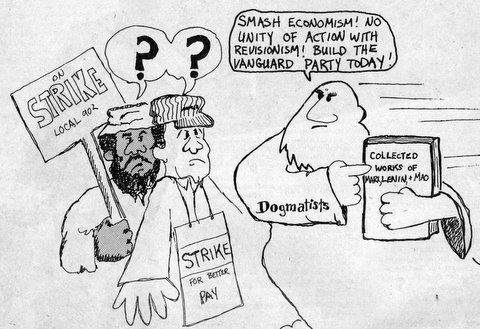
The resulting ideological-political break allowed the new trend to begin to explore the deeper roots of its differences with the rest of the anti-revisionist movement and to focus on what it increasingly saw as the dogmatism, theoretical poverty and political irrelevance of the major anti-revisionist parties and groups while still identifying with Marxism-Leninism and party-building. And, while the new trend remained critical of Soviet revisionism, it was not hostile toward Cuba, Vietnam, North Korea considered revisionist by most NCM groups.
The Guardian newspaper played a leading national role in the emergence of the trend and, as Executive Director Irwin Silber toured the country in 1976, he progressively expanded the scope of his critique of the “social chauvinism” of proponents of the Chinese foreign policy line to address the need for a new anti-dogmatist party building project. In June 1977, the Guardian published a special supplement “On Building the New Communist Party,” setting forth its views and followed up with the formation of Guardian Clubs across the country to promote its party building efforts.
The Guardian party building initiative, however, was not the only one to emerge from the new trend.
Prior the Guardian supplement, in 1976, the Ann Arbor Collective (Marxist-Leninist) had issued a broadside, Against Dogmatism and Revisionism: Towards a Genuine Communist Party, which questioned the New Communist Movement’s theoretical and political foundations from a perspective influenced by Louis Althusser, Nicos Poulantzas and Antonio Gramsci. The Ann Arbor Collective’s approach was shared by another small group, the Tucson Marxist-Leninist Collective, which began publishing a bi-monthly journal, The Theoretical Review, in October 1977.
A third party building initiative emerged from the anti-revisionist, anti-dogmatist trend that same year.
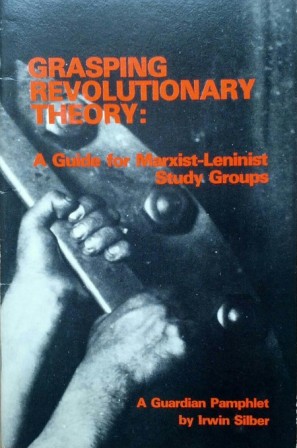
The Philadelphia Workers Organizing Committee (PWOC) brought together like-minded worker-organizing collectives: the Detroit Marxist-Leninist Organization, the Baltimore Socialist Union, the Potomac Socialist Organization (in D.C.) and El Comite-MINP in a semi-formal alliance called the Committee of Five, which sought to pull together other groups around the country that identified with the new trend. Participating in the resulting discussions were collectives in Boston, southern Massachusetts, Buffalo, Louisville, Milwaukee, Orange County, the Bay Area, Cincinnati, and Seattle and other cities.
The basis of unity for these discussions were 18 points of unity drafted by the Committee of Five and issued in January 1977. The Committee of Five’s party building strategy was called “fusion” – the transformation of the composition of its member groups from left intellectuals and ex-students to militant proletarians – through taking communism [agitating for communist politics] to the working class.
In February 1978, the Committee of Five would launch a more formal party building effort – the Organizing Committee for an Ideological Center (OCIC) [to be covered in a subsequent section] – at a conference in Detroit.
The new trend was clear on what divided it from the rest of the anti-revisionist movement. Not so clear was whether it would be any more successful than its New Communist Movement predecessors in coming up with a single party building project capable of uniting all its disparate forces.
| Index of organizations in this section (by alphabetical order) |
| Ann Arbor Collective (Marxist-Leninist) |
| Committee of Five |
| –––Philadelphia Workers Organizing Committee |
| –––El Comité-MINP |
| –––Socialist Union of Baltimore |
| –––Potomac Socialist Organization |
| –––Detroit Marxist-Leninist Organization |
| Guardian Clubs |
| Guardian-PWOC Exchanges on Party Building |
| Tucson Marxist-Leninist Collective – Theoretical Review |
Family Tree Chart of U.S. Anti-Revisionism, 1956-1977 by the Communist Workers Group (Marxist-Leninist)
The Trend by Ethan Young
Guardians of “Socialist” Opportunism by the Communist Workers Group (Marxist-Leninist)
Beginning Analysis by the Bay Area Communist Union
The Failure of the Left to Create a Mass Movement and a Way Forward by the Political Education and Action Collective
A Critique of Ultra-Leftism, Dogmatism and Sectarianism by the Movement for a Revolutionary Left
Against Sham Leninism [Reply to the Movement for a Revolutionary Left] by the League for Proletarian Socialism
2, 3, Many Parties of a New Type? Against the Ultra-Left Line by the Proletarian Unity League
Debating Strategy: A New Turn for the Movement by the Philadelphia Study Group
Angola and Zaire – Where the Vanguards Failed, Part I by John Witeck
Angola and Zaire – Where the Vanguards Failed, Part II by John Witeck
Zaire: Crucial Stakes Involved by John Witeck
Is International Line a Correct Line of Demarcation within the Anti-“left” Tendency? by the Communist Unity Organization
Rectify the Communist Movement, Re-establish the Communist Party! by the Milwaukee Alliance
On the U.S. Anti-Revisionist Movement’s Anti-Left Tendency by People’s Democracy
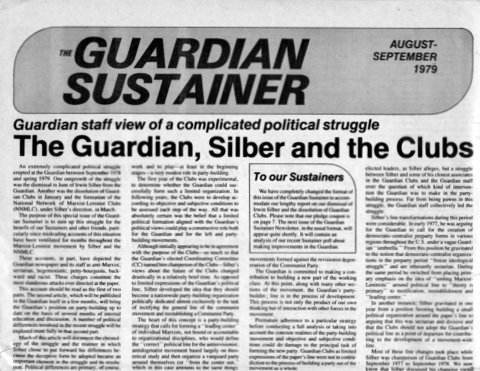
The Guardian newspaper had been involved with the New Communist Movement (NCM) since at least 1973, when it had sponsored a series of forums on issues of concern to the movement which involved the Revolutionary Union, October League, Black Workers Congress and other groups.
In 1976, the Guardian’s questioning of Chinese policy in the Angolan civil war and its outspoken opposition to NCM groups who argued that “we should strike the main blow against the USSR” drew a positive response from many independent Marxist-Leninists. So much so, that late in 1976, the Guardian decided to become organizationally involved in the struggle to build a new Communist Party.
In the Spring of 1977, it proposed the formation of a national network of Guardian Clubs to promote the paper and party building and in June published a special supplement “On Building the New Communist Party,” setting forth its views on both party building issues and the goals and activities of the proposed Clubs. When the Clubs were formed later that year, initially in ten cities, Guardian Executive Editor Irwin Silber was named Chairman.
The Guardian, Silber and the Clubs
’...fan the flames’ [roadblocks to party building] by Irwin Silber
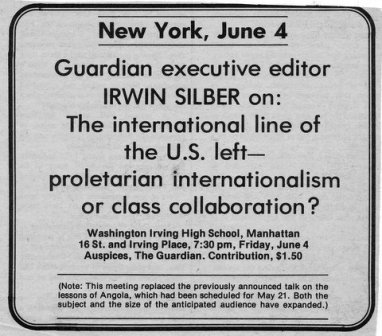
’...fan the flames’ by Irwin Silber
’...fan the flames’ [in defense of the dictatorship of the proletariat] by Irwin Silber
’...fan the flames’ by Irwin Silber
Revisionism bows to ’practicality’ by Irwin Silber
Guardian executive editor tours midwest. Role of U.S. left discussed
950 Hear Guardian Editor on U.S. Left by Barbara Miner
Editorial: A successful Guardian forum
On Party Building by Irwin Silber
Guardian to boost party-building
Defining party building issues by Irwin Silber
The party must be multinational by Irwin Silber
Anticommunism takes many forms by Irwin Silber
The struggle against dogmatism by Irwin Silber
Party-building: ’Precondition’ by Irwin Silber
More thoughts on Guardian Clubs proposal by Jack A. Smith
On Building the New Communist Party [Special Guardian Party-Building Supplement]
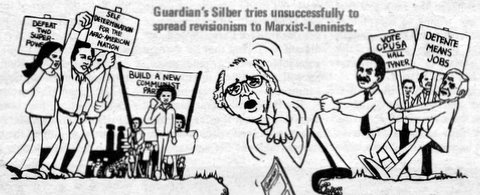
Guardian Clubs Study Guide [for the Special Guardian Party-Building Supplement]
Discussion of supplement moves ahead by Irwin Silber
Guardian making organizational plans for Clubs by Jack A. Smith
Guardian Clubs’ principles of unity
Outline of Clubs’ political activities by Irwin Silber
Guardian 10 Points: Revisionism’s Bare Bones by the Communist Party (Marxist-Leninist)
Exposing ultra-’left’ illusions/PUL downplays international line by Irwin Silber
Party-Building Line and the Fight against “Left” Opportunism [PUL reply to Irwin Silber]
Guardian Clubs and Party-Building by Irwin Silber
Grasping Revolutionary Theory: A Guide for Marxist-Leninist Study Groups A Guardian pamphlet by Irwin Silber
Letter to Guardian Supporters [Reply to Clay Newlin] by Irwin Silber
[Back to top]
The Ann Arbor Collective was formed in the summer of 1976. It included former members of SDS, as well as people who had experience in or around other Marxist-Leninist groups including the Revolutionary Communist Party, October League and the Tucson Marxist-Leninist Collective. The impetus for starting the group was the crisis in the new communist movement provoked by developments in Chinese foreign policy, primarily its response to the liberation struggle in Angola. One of its first activities was to sponsor a speech by Irwin Silber in Ann Arbor on the crisis of the U.S. Communist movement as part of his Midwest speaking tour in May 1976.
The Collective published two pamphlets: Against Dogmatism and Revisionism: Toward a Genuine Communist Party in November 1976 and On Party Building in April 1977.
The Collective dissolved in 1978 after many of its members left Ann Arbor.
Against Dogmatism and Revisionism: Toward a Genuine Communist Party
Party building: ’Against dogmatism, revisionism’ by William Gurley
Conference Statement of the Ann Arbor Collective (M-L)
Letter to the Ann Arbor Collective from Irwin Silber
[Back to top]

The Tucson Marxist-Leninist Collective (TMLC) was organized in 1975. It represented the merger of two groups of individuals: a larger group which had formerly belonged to a local revolutionary organization, the John Brown Party, and a smaller group of communist students at the University of Arizona.
Initially, the TMLC concentrated on studying, cadre development and local work. By 1977, however, it turned it attention to the national party building movement, publishing a paper on the party-building question, initiating a relationship with the Committee of Five and its “organizing committee for an ideological center,” and launching a bi-monthly journal, the Theoretical Review, which continued publishing until 1983.
The TMLC pioneered a party building line dubbed “primacy of theory,” which argued that theoretical tasks were primary in the communist movement in this period and an essential pre-condition for the successful unification of Marxist-Leninists and their fusion with the workers’ movement. Through the Theoretical Review, this line was propagated nationally and as a result, Theoretical Review editorial boards and/or support groups were set up in cities across the country, including Boston, Chicago, San Francisco, New York, Minneapolis-St. Paul, and Los Angeles.
With the collapse of the new communist movement in the 1980s, the Theoretical Review was discontinued in 1983 and the TMLC dissolved shortly thereafter.
A Short History of the Tucson Marxist-Leninist Collective
Letter from the August 29th Movement
Letter from the Committee for Scientific Socialism (Marxist-Leninist)
Program of the Tucson Marxist-Leninist Collective
On the International Situation
Party Building Tasks in the Present Period. On Theory and Fusion
Introduction to the Tucson Marxist-Leninist Collective
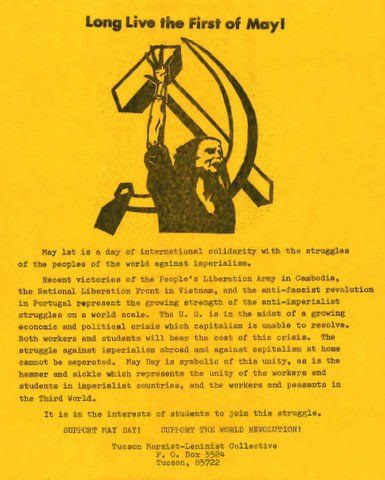
Support Busing, Not Racism [version 1]
Support Busing, Not Racism [version 2]
Support Affirmative Action! Oppose Bakke!
Stop Rape! Uphold Women’s Rights to Self-Defense!
U.S. and Mexican Workers Unite! Stop Deportations!
Support Workers’ Right to Strike
False and True Friends of the Jewish People
Workers Unite [poster]
Is the Communist Party a Revolutionary Alternative?
[Back to top]
The Committee of Five began to come together at the beginning of 1976. Initially it consisted of the Philadelphia Workers’ Organizing Committee (PWOC), the Detroit Marxist-Leninist Organization (DMLO), El Comité, and the Socialist Union of Baltimore (SUB). In June, with the inclusion of the Potomac Socialist Organization (PSO), it became the Committee of Five.
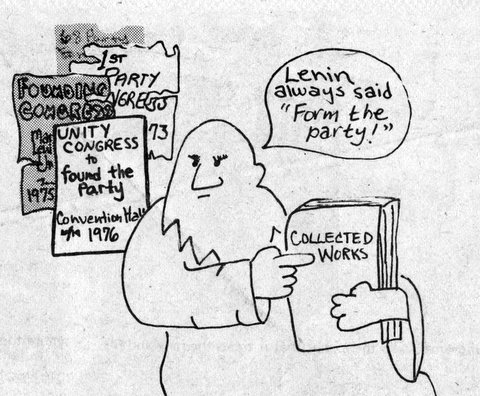
In June 1976 the original four groups issued a public call for a conference of Marxist-Leninists who associated themselves with an emerging “trend” in the New Communist Movement against “dogmatism”. Conceding that the “trend” was very undeveloped, the letter stressed the need to define “the unities and differences within it” through “principled discussions with other organizations and individuals throughout the country”.
The letter drew broad support among US Marxist-Leninists and led to an anti-dogmatist party-building meeting in September 1976 in which many groups, including the Guardian, participated.
The next step in the Committee’s process was the development and distribution of an 18-point draft of Principles of Unity for a Marxist-Leninist Conference was circulated in the first weeks of 1977. The two most critical of the 18 points were numbers 15 and 18. The former point identified “modern dogmatism” as “the main opportunist danger” within the party-building movement in the present period. The latter point identified U.S. imperialism as “the main enemy of the world's people” (this point was redrafted at a Trend Conference Planning Committee Meeting in August 1977 to define “left” opportunism, not dogmatism, as the main danger to the U.S. Anti-Revisionist Movement). While most Trend groups argued for a party building strategy called “fusion” which prioritized the fusion of Marxism-Leninism with the workers’ movement, agreement on party building strategy was not a requirement for participation in the Committee of Five’s process.
In addition to modifying Point 15, the August meeting also adopted a Draft Resolution for a Leading Ideological Center, put forward by four of the five groups (El Comité presented an alternative proposal to the meeting, which was defeated).
In February 1978, a conference of the Committee and other Trend groups formalized the creation of the Organizing Committee for an Ideological Center (OCIC) and adopted the 18 Points of Unity as amended in August.
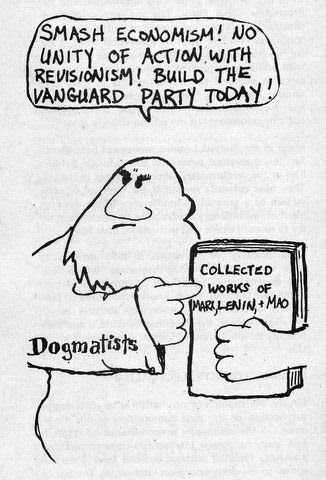
Chinese Foreign Policy – A Critical Analysis
The sickness on the left – Dogmatism and the ’Revolutionary Phrase’
Dogmatism and the Struggle for the Party
Dogmatism and the Rank & File Movement – The road to isolation
On combatting ’straw men’ by Clay Newlin
Dogmatism and Black Liberation by Jim Griffin
Marxist-Leninists must lead the fight for democratic rights by J. Reed
Dogmatism and the International Question by J. Reed
Dogmatism: the root of opportunism in our movement by Clay Newlin
An Analysis of the Guardian’s Party-building View (part 1) Deepen the Criticism of Dogmatism by Ron Whitehorne
The Guardian Clubs and our party-building tasks by Clay Newlin
Party Building and its Relationship to the Masses
Principles of Unity of the Socialist Union of Baltimore
Introduction to Socialism [introductory study for advanced workers]
Basic Economics of Capitalism [questions for advanced workers]
Fundamentals of Marxism-Leninism [study guide]
Sum Up and Analysis of CLUW in Baltimore, SUB’s Role
On the Party-Building Question
More Than Patches. A Study of the Trade Union Question
Black Liberation: A Preliminary Perspective
Education in Detroit: Busing and the Dual System
* * *
Letter sent to various Communist organizations by the Committee of Five
Letter to the TMLC and Other Groups by the Proletarian Unity League
Response to the Committee of Five by the Proletarian Unity League
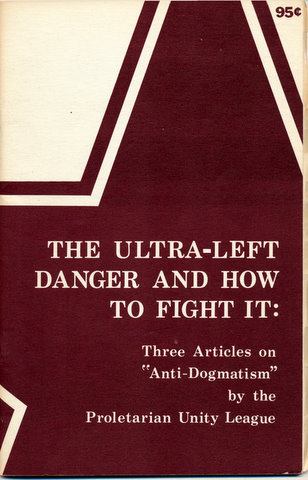
Statement on the Letter from the Committee of Five and the Response of the Proletarian Unity League by the Tucson Marxist-Leninist Collective
More on Dogmatism and the Main Danger by the Proletarian Unity League
Conference Statement of the Ann Arbor Collective (M-L) by the Ann Arbor Collective (Marxist-Leninist)
Draft Unity Principles for a Marxist-Leninist Conference by the Committee of Five
Letter from the Committee of Five [The Five Questions]
Bring Home the Struggle Against “Left” Sectarianism: A Further Response to the Committee of Five by the Proletarian Unity League
On the Small Consequences of Sectarianism by the Proletarian Unity League
Draft Resolution for a Leading Ideological Center by the Committee of Five
The Formation of a Leading Ideological Center – comments by the Buffalo Workers’ Movement
Proposal for Building Our Embryonic Trend and Its Ideological Center by the Los Angeles Work Group
Forging a Ideological Center by the Boston Organizing Committee
In Response to the Boston Party-Building Organization by the Philadephia Workers’ Organizing Committee
On Our Differences over Party-Building: A Reply to the PWOC by the Boston Party-Building Organization
Dogmatism, the Main Enemy, and “Left” Opportunism [Reply to PUL] by Clay Newlin for the Committee of Five
[Back to top]
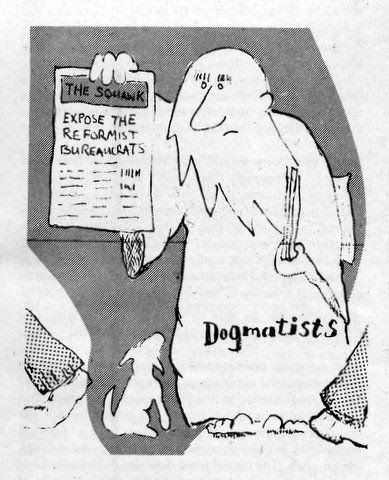
Party-Building and Trade Unions by Irwin Silber
On Combatting “Straw Men” by Clay Newlin
Economism Blocks Party-Building by Irwin Silber
Praise Lenin Less, Study Him More Diligently by Clay Newlin
An Analysis of the Guardian’s Party-building View (part 1) Deepen the Criticism of Dogmatism by Ron Whitehorne
The Guardian Clubs and our party-building tasks by Clay Newlin
Letter to Guardian Supporters [Reply to Clay Newlin] by Irwin Silber
[Back to top]